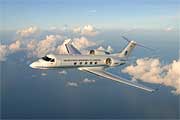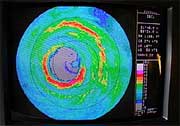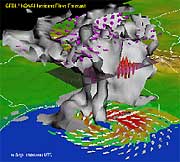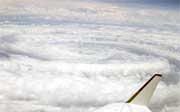
skip to content program navigation
| Learn more about these WEATHER RESEARCH areas... |
Hurricanes
Hurricane or Typhoon is a tropical cyclone in which the maximum sustained surface wind (using the U.S. 1-minute average) is 64 kt (74 mph or 119 km/hr) or more. Tropical Cyclones originate over tropical or subtropical waters, with organized deep convection and a closed surface wind circulation about a well-defined center. The term hurricane is used for Northern Hemisphere tropical cyclones east of the International Dateline to the Greenwich Meridian. The term typhoon is used for Pacific tropical cyclones north of the Equator west of the International Dateline.
Hurricane Research
NOAA's research scientists are engaged in several approaches to better understand and predict tropical cyclones. These investigations involve theoretical studies, computer modeling, and the collection and examination of measurements taken in actual hurricanes. The ultimate goal is to improve scientific understanding of how and why hurricanes form, strengthen, and dissipate, which will lead to improved forecasting of tropical weather and mitigation of damage from the hurricane's destructive power.
Field Research
One mission of NOAA's Atlantic Oceanographic and Meteorological Laboratory (AOML) is to advance the understanding and prediction of hurricanes and other tropical weather. Hurricane research at AOML includes direct remotely-sensed observations of both hurricanes and the ocean underneath their predicted path. However, observations made inside the inner core of tropical cyclones and their surrounding atmosphere is of critical importance to NOAA's research.
A key aspect this research is an annual field program of flights aboard research aircraft (two WP-3D turboprops and a Gulfstream IV-SP jet) flown by NOAA's Aircraft Operations Center. These aircraft feature on-board instrumentation such as radars, fixed probes to measure cloud and aerosol particles, expendable probes to measure wind speed temperature and pressure, as well as instruments that are able to remotely determine wave height and sea surface temperature.
The field program is used to carry out scientific experiments designed to address NOAA's priority research goals. Data sets gathered by these experiments, combined with dynamical and statistical models and theoretical development, range from global to microscale, from seconds to centuries.
The goals of this research are to:
- Advance the prediction of tropical cyclone intensity change;
- Improve the prediction of tropical cyclone tracks;
- Improve the understanding of and ability to predict tropical cyclone frequency and intensity on long time scales; and
- Enhance the ability to diagnose and predict the impact of tropical cyclones on life and property.
A major aspect of the field effort over the next few years will focus on collecting data sets to evaluate and improve the next generation hurricane forecast model system.
Computer Modeling Research of Hurricanes
NOAA also houses a laboratory that focuses on theoretical and modeling studies of hurricanes - the Geophysical Fluid Dynamics Laboratory (GFDL). Here, scientists use numerical simulation models to understand the origin, development and eventual decay of tropical disturbances by investigating the atmospheric and oceanic processes that influence them. NOAA scientists also study the small-scale features of hurricane systems as well as the capability of numerical models to predict hurricane movement, intensity and rainfall. GFDL scientists are also working very closely with the NOAA Environmental Modeling Center on the development of the next generation hurricane forecast modeling system. This model eventually will be used to create real-time tropical forecasts by hurricane specialists at NOAA's National Hurricane Center.
Coordination and Projects
NOAA's hurricane research maintains active programs with, and receives funding from other governmental agencies, in particular, the Department of the Navy's Office of Naval Research (ONR) and the National Aeronautics and Space Administration (NASA). In program areas where it is beneficial, NOAA arranges co-operative programs with scientists at the National Center for Atmospheric Research in Boulder, Colorado, and at a number of universities. One of the recent high priority experiments is a study of the upper-ocean heat content. Other projects include the Coordinated Boundary Layer Air-Sea Transition (CBLAST) experiment focused on improving numerical models of the energy transfer between sea and air that fuels hurricanes.
|
NOAA's Gulfstream-IV jet is used in hurricane research and reconnaissance.
The eye of hurricane Isabel as viewed from one of the NOAA P3 on-board Doppler radar instruments.
Three-dimensional view of Hurricane Floyd as it approached landfall at Cape Fear on September 16, 1999.
Dropwindsondes are deployed from hurricane aircraft and drift downward on a parachute measuring vertical profiles of pressure, temperature, humidity and wind as they fall.
The eye of Hurricane Edouard as viewed from NOAA's Gulfstream-IV jet |
NOAA Research programs that study Hurricanes
![]() Atlantic
Oceanographic and Meteorological Laboratory
Atlantic
Oceanographic and Meteorological Laboratory
![]() Geophysical
Fluid Dynamics Laboratory
Geophysical
Fluid Dynamics Laboratory
NEXT -- Tornadoes and Thunderstorms





